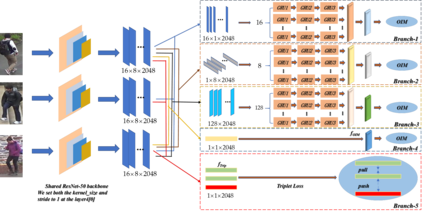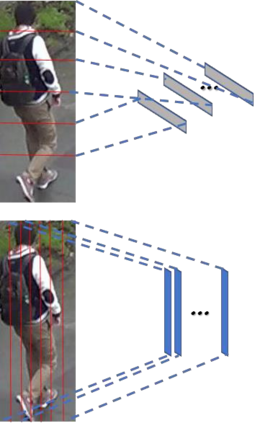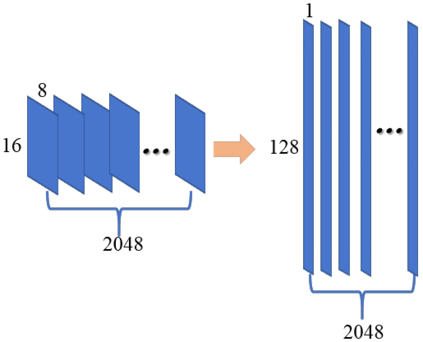Person re-identification (PReID) has received increasing attention due to it is an important part in intelligent surveillance. Recently, many state-of-the-art methods on PReID are part-based deep models. Most of them focus on learning the part feature representation of person body in horizontal direction. However, the feature representation of body in vertical direction is usually ignored. Besides, the spatial information between these part features and the different feature channels is not considered. In this study, we introduce a multi-branches deep model for PReID. Specifically, the model consists of five branches. Among the five branches, two of them learn the local feature with spatial information from horizontal or vertical orientations, respectively. The other one aims to learn interdependencies knowledge between different feature channels generated by the last convolution layer. The remains of two other branches are identification and triplet sub-networks, in which the discriminative global feature and a corresponding measurement can be learned simultaneously. All the five branches can improve the representation learning. We conduct extensive comparative experiments on three PReID benchmarks including CUHK03, Market-1501 and DukeMTMC-reID. The proposed deep framework outperforms many state-of-the-art in most cases.
翻译:个人再身份(PReID)因其在智能监视中的重要性而日益受到越来越多的关注。最近,许多关于PREID的先进方法都是基于部分的深层次模型,其中多数侧重于从横向方向学习人身体的部分特征代表;然而,垂直方向的人体特征代表通常被忽视;此外,这些部分特征和不同特征渠道之间的空间信息不考虑垂直方向;在本研究中,我们为PREID引入了一个多管深层模型。具体地说,该模型由五个分支组成。在五个分支中,两个分支分别从横向或纵向方向学习空间信息,其中两个分支学习当地特点,另一个侧重于学习上一个相变层产生的不同特征渠道之间的相互依存知识。另外两个分支的剩余部分是识别和三重子网络,在这些网络中,可以同时学习歧视性的全球特征和相应的测量。所有五个分支都可以改进代表性学习。我们对PREID的三个基准进行了广泛的比较试验,包括CUHK03、市场1501和DUGMMMC-ID。在大多数案例中,拟议的深层次框架超越了许多案例。









